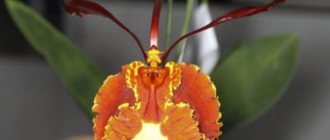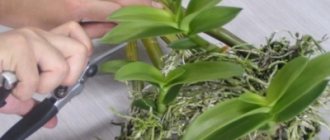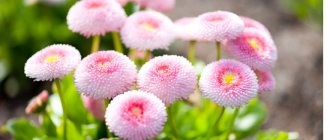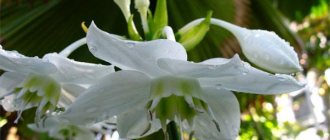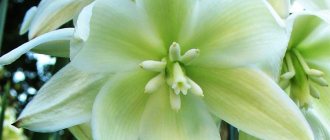Psychopsis is an epiphytic plant that belongs to the Orchidaceae . Until recently, this orchid was classified in the genus Oncidium , but relatively recently it was separated into a separate genus. This plant is native to the tropical forests of Latin America and its adjacent islands. Psychopsis is a very attractive orchid and quite popular among experienced orchidists .
Orchids bloom in winter, December-February. After flowering, the peduncle does not fade, and it is not worth removing it, since flowers will still bloom on it in subsequent flowering seasons, for many years. Flowering lasts about a month.
Psychopsis krameriana. ©Orchi
Description
More than a century passed from the moment Psychopsis was described until it received genus status.
Initially, orchids collected in a separate section were classified as Oncidium. Only at the end of the last century a small (only five species) genus acquired independence. The habitat of these epiphytic orchids is the mainland and islands of Central and South America. Fine plant roots cling to the bark of trees in tropical forests. Psychopsis pseudobulbs are small (3.5–5 cm in height), flattened, green. False bulbs produce one leaf at a time. The leaf blades are long, lanceolate, rigid, slightly bent along the median vein. Dark green leaves have a reddish tint. In addition, the reverse surface is often decorated with a scattering of purple spots.
IN THE PHOTO: Flattened unifoliate pseudobulbs of Psychopsis.
A thin peduncle extends from the base of the pseudobulb. The length of the vertical flower arrow reaches up to a meter. As a rule, it bears a single bud. Sometimes a flower shoot branches, then the number of flowers increases.
IN THE PHOTO: Psychopsis peduncle with bud.
One look at the blooming Psychopsis is enough to understand why the name of the genus is translated from Greek as “like a butterfly.” Indeed, large flowers are very similar to beautiful insects. A large three-lobed lip with corrugated edges is the abdomen, oblong fused lateral sepals are the wings, a vertical column is the head, narrow petals and the upper sepals are the antennae.
IN THE PHOTO: The Psychopsis flower is like a fluttering butterfly.
Red-brown, cream, yellow flowers, decorated with spots, appear one after another. Each of them lasts 3-4 weeks. Revolving flowering lasts for many months.
As a result of interspecific crossings, the following hybrids were obtained: P. Kalihi, P. Pavane, P. Butterfly. These hybrids and their varieties have also been used in breeding to create P. Mariposa, P. Mendenhall, P. John D. Ramsey and others. Artificially bred plants are famous for their unpretentiousness and long-lasting (up to 2 years) flowering. True, like natural species, the flowers of these orchids are devoid of fragrance.
Description of the plant
Orchid psychopsis is a perennial epiphytic plant. It has long, slightly curly roots, above which there is a pear-shaped bulb 3-4 cm long. The roots are painted white, and the skin of the bulb has a dark green, uniform color. Some varieties have slightly wrinkled bulbs.
2 oblong or broadly lanceolate leaves bloom from the base of the bulb. Dense, smooth leaves have a smooth lateral edge and a pointed end. The length of the leaves is 15-20 cm, and the width is 5-9 cm. The leaves have a dark green surface covered with small speckles and lighter spots.
The flowering period is December-February. A peduncle up to 120 cm long blooms from the base of the pseudobulb. It bears one, rarely two flowers with a diameter of up to 8 cm. Surprisingly, the peduncle does not dry out after the flowers wither. It can persist for many years, gradually releasing new buds.
The closed bud resembles a butterfly pupa, which gradually crawls out of its hiding place. The petals are yellow-orange with many orange and terracotta spots. At the top there are three very long and narrow sepals. The lateral sepals are more rounded or teardrop-shaped and are adjacent to a wide, fan-shaped lip. In the central part of the brownish lip there is a bright yellow spot. Each flower lives 1-2 weeks.
Growing
To grow Psychopsis, you need a clay or plastic pot with drainage holes. A mixture of medium pieces of pine bark, charcoal, and expanded clay is recommended as a substrate. You can also use other components: polystyrene foam, nut shells. The main thing is that the soil is moisture- and breathable.
IN THE PHOTO: The substrate for Psychopsis includes medium-sized pine bark, coal and expanded clay.
It is the condition of the substrate that determines the need for transplantation. On average, this procedure is carried out once every two to three years. It is better to wait for the new growth to form its own roots. Unlike most Orchids, Psychopsis tolerates transplantation easily and recovers quickly. Nevertheless, proper preparation of the container and disinfection of the soil mixture are essential responsibilities of the owner.
Psychopsis is propagated in culture by dividing the bush. It is advisable to leave three pseudobulbs for each new specimen. When planting a cutting in a pot, you should place the old false bulbs closer to the wall. This leaves more room for young people to develop. After dividing and replanting, watering is canceled for some time.
Soil, planting and transplanting psychopsis at home
Soil for psychopsis orchid:
For cultivation, only special soil mixtures for orchids are used. If the flower shop does not have special soil in stock, you can make it yourself by mixing pine bark, peat, drainage and adding more charcoal and sphagnum moss.
Correct transplantation of the psychopsis orchid:
The orchid is replanted as needed, as soon as the roots begin to grow through the drainage holes, as they will begin to dry out, and this will harm the plant and the root system as a whole.
The psychopsis pot should be low, wide, and not transparent. If you purchased a tall pot, it is better to fill ½ of it with drainage. Place a couple of heavy stones on the bottom for stability, then add a thick layer of drainage and a layer of fresh soil, and only then transfer the orchid itself, filling all the voids with new substrate.
Psychopsis kalihi. ©A_and_B_Larsen
Secrets of success
Psychopsis feels most comfortable at year-round air temperatures of +25°C during the day and +20°C at night. However, the plant is able to adapt to summer heat (up to +32°C) and winter cold (not lower than +15°C).
These orchids need long (10-11 hours) daylight hours. But they need to be protected from direct sunlight. In apartment conditions, it is recommended to use lighting from autumn to spring.
Since Psychopsis does not have a rest period, watering is carried out throughout the year. An indispensable condition: the soil must have time to dry. In winter, procedures are performed less frequently, reducing the volume of fluid. Partial immersion watering gives good results. With the usual method, you need to make sure that water does not get on new growths and flower stalks.
There are no breaks in feeding orchids. Special fertilizers of reduced concentration are applied in spring and summer with every second watering, and less frequently in autumn and winter.
Psychopsis does not have any special requirements for air humidity. If there is a need to install humidifiers, it is necessary to increase the frequency and duration of ventilation.
Plants live happily outdoors from May to September. True, only in places protected from bright sun, winds and rain.
Known varieties
The type of psychosis is quite modest. It contains only 5 species and several hybrid varieties. The most popular varieties among gardeners are the following.
Psychopsis moth or butterfly. Shallow wrinkles are visible on the pseudobulb, 3-4 cm high. Two dark green leaves with a marbled pattern bloom from its base. The peduncle is 120 cm long and bears one bud. The petals and stipules are orange and covered with brown spots. There is a large bright yellow spot on the central part of the lip. Flowers of this species are larger in size and rich in color.
Psychopsis moth or butterfly
Psychopsis krameriana. The plant has flat, oval bulbs 3-5 cm high. A pair of wide lanceolate leaves, densely covered with reddish specks, bloom from the base of the bulb. The length of the leaf plate is 15-20 cm, and the width is 5-7 cm. A single flower with a diameter of 6-8 cm blooms on a smooth peduncle up to 60 cm long. The petals are painted yellow and covered with red-brown spots.
Psychopsis krameriana
Psychopsis limminghei. The plant is compact in size. The flattened bulb does not exceed 2 cm in diameter. A pair of oval dark green leaves are covered with small dark dots. The leaf length is 3-5 cm, and the width is 2-3 cm. One flower blooms on a peduncle about 10 cm long. Its diameter is 4 cm. The color of the petals contains yellow, red and brown tones. The lighter, rounded lip is almost free of blemishes.
Psychopsis limminghei
Psychopsis sanderae. The plant is distinguished by the fact that 2-3 buds bloom simultaneously on the peduncle. The central part of the flower is yellow and devoid of spots; they are grouped along the edges of the petals and sepals.
Psychopsis sanderae
Psychopsis alba. The variety is distinguished by a more delicate color of the petals. There are no dark, contrasting fragments in it. The central part of the flower is painted yellow or sandy, and orange spots are located closer to the edges.
Psychopsis alba
Possible difficulties
If after transplanting or dividing the plant's false bulbs shrivel, there is no need to worry. After rooting and resumption of watering, the pseudobulbs are completely restored.
Flowering can be stimulated by a short-term decrease (up to +18°C) in air temperature and a reduction in watering. You will also need to increase the lighting level.
To protect the long peduncle from breakage, it is recommended to install a thin support. By the way, a faded flower shoot should not be removed until it is completely dry. Until then, the likelihood of new flowers appearing is high.
It is very important to monitor the condition of the leaves.
Changes in foliage color indicate excessive/insufficient watering, too bright or too weak lighting. In addition, a dangerous pest, the spider mite, lives on the leaf blades. Editorial team LePlants.ru
Reproduction of psychopsis at home
Psychopsis reproduces vegetatively. This method of propagation is applicable to adult plants that have children at the roots. The separation of children is carried out during transplantation, as soon as there are at least 6 of them, the soil must be completely dry before the procedure. The roots are completely freed from the substrate and carefully unraveled; heavily tangled areas are cut with a knife, and the cut areas are treated with crushed charcoal or activated carbon.
When dividing, it should be taken into account that each division must have at least 3 pseudobulb shoots. Each young specimen is planted in its own container and immediately placed in its usual place for growth. After the division procedure, the plants are not watered for at least a week.
Views: 844
Rules of care
At home, psychopsis is easy to care for. Many consider it an unpretentious houseplant. It grows normally in shaded areas, in diffused light, and also in bright sun. However, the plant may suffer from midday sunlight on the windowsill. It is necessary to create shade or expose the plant to fresh air.
The greatest difficulty for owners may be maintaining temperature conditions. It is important to withstand daily fluctuations. During the day, the orchid is kept at +18...+25°C, and at night the temperature is reduced to +14...+21°C. At the same time, higher temperatures promote abundant flowering. The flowering process itself requires a lot of vitality, so only mature, strong plants are allowed to bloom continuously.
Psychopsis is a drought-resistant orchid. Between waterings, the substrate should have time to dry completely. Water for irrigation should be soft and warm (+30…+40°C). Air humidity is not particularly important. It is recommended to periodically wipe the leaves from dust. Spraying for psychopsis is undesirable. If drops of water accumulate in the axils of the leaves or on the bulb, fungal diseases may develop. To increase air humidity, it is better to use trays with wet pebbles.
From April to October, fertilizer is added monthly to the irrigation water. It is necessary to use special compounds for orchids. While leaves and flower stalks are developing, preference is given to preparations with a large amount of nitrogen. Before flowering, they switch to complexes with phosphorus.
Psychopsis is resistant to disease, but with excessive watering, signs of rotting may appear on its bulb and leaves. At the initial stage, you can dry the soil and treat the plant with antifungal drugs. In advanced cases, it is rarely possible to save an orchid.
Sometimes succulent leaves are attacked by scale insects, mealybugs or spider mites. If parasites are detected, it is best to immediately treat the plant with insecticides (Aktara, Karbofos).
Conditions of detention
Temperature
Psychopsis belongs to a moderate-warm temperature regime.
Summer: during the day up to + 25 °C, at night 18-20 °C. Winter: not lower than + 15 °C.
The Psychopsis orchid can adapt to summer heat (up to +32°C) and winter cold (not lower than +15°C).
Lighting
Psychopsis needs a long daylight hours of 10–11 hours, but must be protected from direct sunlight. In apartment conditions, it is recommended to use lighting from autumn to spring .
The best windows are eastern and south-eastern facing.
Bright sunlight is the main prerequisite for flowering of this type of orchid. If there is insufficient lighting, the orchid will not bloom.
